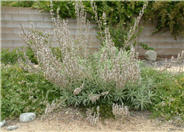
Common name:White Sage, Sacred White Sage, Bee
Botanical name:Salvia apiana
This woody shrub has long stems with silvery white leaves and fragrant white flowers that bloom in the spring. It provides a strong sturctural form as a garden focal point. It can reach 3'-5' tall and 6' wide. White sage prefers full sun and moderate amount of watering.

Common name:Bush Anemone
Botanical name:Carpenteria californica
This California native is a dense, clean evergreen shrub that grows 6'-8' high and 5' wide. It is tolerant of sun or shade. It has white fragrant flowers with yellow stamens flowers that bloom in spring and summer. This shrub makes a great privacy hedge. It is drought tolerant once it's established but will appreciate extra watering during hot summer months.

Common name:Dr. Hurd Tree Manzanita
Botanical name:Arctostaphylos manzanita 'Dr. Hurd'
This is a large shrub that has a tree-like shape,reaching 8-20' tall and wide. It has dark red bark with multi-branched form, large pale green leaves, and white to pink flower clusters that bloom in winter. This shrub can be grown near the ocean but also in warm inland valleys. It prefers full sun and is drought tolerant once it's established.

Common name:Blue Blossom Ceanothus
Botanical name:Ceanothus thyrsiflorus 'Skylark'
The Blue Blossom Ceanothus is a shrub that has dark blue flower clusters that bloom profusely in the spring . 'Skylark' grows to 5' tall and wide. This shrub attracts butterflies, hummingbirds and beneficial insects. Evergreen foliage is dark green and shiny, densely covering the plant. 'Skylark' tolerates heat better than other cultivars. It is drought tolerant once it's established. It prefers full sun to partial shade.

Common name:Coast Redwood, Redwood
Botanical name:Sequoia sempervirens
This fast-growing, aromatic tree has soft, dark green foliage with long needles appearing in flat sprays and brown, barrel-shaped cones that appear after 1 year. Its soft, red-brown bark is fiberous and furrowed. Particularly after mechanical damage, this tree will stump sprout to form new, young trees around the stump. Avoid planting in areas of high foot traffic. Inadequate moisture or a hot, dry site will inhibit its growth.

Common name:Columnar Italian Cypress
Botanical name:Cupressus sempervirens 'Stricta'
Italian Cypress is often associated with Italian and Spanish architecture, providing columns in the landscape. They often reach 40'- 60' tall. 'Stricta' is compact, columnar and produces long, straight branches with deep green foliage. Once it's established, it is drought tolerant. Provide well draining soil. Do not plant near ocean.

Common name:California Wild Grape
Botanical name:Vitis californica
The California Wild Grape is a woody deciduous vine with round large leaves. Small fragrant blooms appear in spring and berry clusters appear in the summer. This vine has sprawling , climbing growth habit. The California Wild grape is native to CA. It prefers full sun and well draining soil with regular watering.

Common name:Moonshine Yarrow, Milfoil, Sneezewo
Botanical name:Achillea 'Moonshine'
Long, straight stems with pale yellow flowers are striking on the mats of green to grey-green leaves of this plant, which are flatter and less divided than those of the Achillea millefolium. This Yarrow propagates easily from rooted cuttings or divisions which should be performed in the early spring or fall. Following bloom, one should dead head the plant and divide the clumps when it appears crowded. Introduced by Alan Bloom in the 1950's.

Common name:California or Golden Poppy
Botanical name:Eschscholzia californica
This small annual (sometimes acts as a perennial) plant will grow to less than 1' tall and has light, small blue-green leaves with gold and orange flowers that bloom in spring and summer.

Common name:Lindheimer's Muhly
Botanical name:Muhlenbergia lindheimeri
Native to Mexico and TX, this stunning clump-forming grass is a winter dormant grass in cold climates, but usually semi-deciduous in mild climates. From the fall into winter emerge the 5' tall upright flower inflorescence, that rise well above the blue- gray foliage. The flowers are at first purple, then mature to a grey color. Best in full sun with regular watering but will tolerate drought and light shade. -Randy Baldwin
San Marcos Growers

Common name:California Buckeye
Botanical name:Aesculus californica
The Aesculus californica is a tree that slowly grows to 12'- 15' tall. Creamy pink or white fragrant flowers bloom in the spring. When late summer arrives, these leaves drop to unveil pear-shaped fruits. It should be noted that all parts are poisonous. Buckeye has a decorative bark and branch structure. It needs regular water for a few years and then will become drought tolerant.

Common name:Incense Cedar
Botanical name:Calocedrus decurrens
The cedar is an attractive, stiff, narrow evergreen tree which has a columnar growing pattern and maintains a central leader. The foliage is comprised of scale needles, while the coarse bark has an attractive cinnamon red-brown coloring. The cedar typically retains its color in winter. It serves as an effective screening. It will slowly grow to 30' tall and 15' wide. Small brown cones appear in summer. Foliage is aromatic when brushed. It has low watering needs once it's established.
| Designer: | Backyard Native Bed |
Photographer: GardenSoft |
Soils and Compost:
Maintain a two to four inch layer of mulch on the soil surface to reduce weeds, infiltrate rain water, and reduce compaction.
Water Saving Tip:
In general, lawns only need to be watered once every three days.
Check your irrigation controller and reduce watering times if necessary.
Integrated Pest Management:
Develop healthy soil for plants that are vigorous and naturally pest-resistant.

